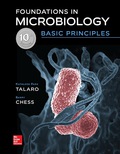
EBK FOUNDATIONS IN MICROBIOLOGY: BASIC
10th Edition
ISBN: 9781259916045
Author: TALARO
Publisher: MCGRAW HILL BOOK COMPANY
expand_more
expand_more
format_list_bulleted
Concept explainers
Question
Chapter 1.L1, Problem 14MCQ
Summary Introduction
To determine:
The correct order of size for the given items, using the number (1) for smallest and number (8) for the largest.
Introduction:
Microorganisms are invisible to the naked eye. They can only be visualized and studied with the help of a microscope. Different types of microorganisms have different size range and some are much smaller than others.
Expert Solution & Answer
Want to see the full answer?
Check out a sample textbook solution
Students have asked these similar questions
What is the structure and function of Eukaryotic cells, including their organelles? How are Eukaryotic cells different than Prokaryotic cells, in terms of evolution which form of the cell might have came first? How do Eukaryotic cells become malignant (cancerous)?
What are the roles of DNA and proteins inside of the cell? What are the building blocks or molecular components of the DNA and proteins? How are proteins produced within the cell? What connection is there between DNA, proteins, and the cell cycle? What is the relationship between DNA, proteins, and Cancer?
Why cells go through various types of cell division and how eukaryotic cells control cell growth through the cell cycle control system?
Chapter 1 Solutions
EBK FOUNDATIONS IN MICROBIOLOGY: BASIC
Ch. 1.1 - Define microbiology and microorganisms, and...Ch. 1.1 - Name and define the primary fields included in...Ch. 1.1 - Define what is meant by the term microorganism and...Ch. 1.1 - Describe five different ways in which humans...Ch. 1.2 - Prob. 3ELOCh. 1.2 - Prob. 4ELOCh. 1.2 - Prob. 5ELOCh. 1.2 - Prob. 3CYPCh. 1.2 - Observe figure 1.3 and place the microbes pictured...Ch. 1.2 - Prob. 5CYP
Ch. 1.2 - Prob. 6CYPCh. 1.3 - Prob. 6ELOCh. 1.3 - Describe several ways the beneficial qualities of...Ch. 1.4 - Prob. 7ELOCh. 1.4 - Prob. 8ELOCh. 1.4 - Prob. 8CYPCh. 1.4 - Prob. 9CYPCh. 1.5 - Prob. 9ELOCh. 1.5 - Prob. 10ELOCh. 1.5 - Prob. 10CYPCh. 1.5 - Prob. 11CYPCh. 1.5 - Prob. 12CYPCh. 1.5 - Why was the abandonment of the spontaneous...Ch. 1.6 - Define taxonomy and its supporting terms...Ch. 1.6 - Prob. 12ELOCh. 1.6 - Describe the goals of nomenclature and how the...Ch. 1.6 - Prob. 14CYPCh. 1.6 - Prob. 15CYPCh. 1.6 - Explain the binomial system of nomenclature and...Ch. 1.6 - Explain sonic of the benefits of using scientific...Ch. 1.7 - Prob. 14ELOCh. 1.7 - Explain the concepts behind the organization of...Ch. 1.7 - Explain the bases foe classification, taxonomy,...Ch. 1.7 - Prob. 17ELOCh. 1.7 - Prob. 18CYPCh. 1.7 - Prob. 19CYPCh. 1.7 - Prob. 20CYPCh. 1.7 - Archaea are often found living in extreme...Ch. 1.7 - Compare the domain system with the five-kingdom...Ch. 1.L1 - Which of the following is not considered a...Ch. 1.L1 - An area of microbiology that is concerned with the...Ch. 1.L1 - Which process involves the deliberate alteration...Ch. 1.L1 - A prominent difference between prokaryotic and...Ch. 1.L1 - Prob. 5MCQCh. 1.L1 - Abiogenesis refers to the a. spontaneous...Ch. 1.L1 - Prob. 7MCQCh. 1.L1 - Prob. 8MCQCh. 1.L1 - Which scientist is most responsible for finally...Ch. 1.L1 - Prob. 10MCQCh. 1.L1 - Prob. 11MCQCh. 1.L1 - Prob. 12MCQCh. 1.L1 - Prob. 13MCQCh. 1.L1 - Prob. 14MCQCh. 1.L1 - Prob. 15MCQCh. 1.L1 - Prob. 16MCQCh. 1.L1 - Many of the bacteria in Lake Whillans derive...Ch. 1.L1 - Prob. 2CSRCh. 1.L1 - Prob. 3CSRCh. 1.L1 - What does it mean to say microbes are ubiquitous?Ch. 1.L1 - Prob. 2WCCh. 1.L1 - What events, discoveries, or inventions were...Ch. 1.L1 - Prob. 4WCCh. 1.L1 - Explain how microbes arc classified into groups...Ch. 1.L1 - Prob. 6WCCh. 1.L2 - What do you suppose the world would be like if...Ch. 1.L2 - How would you describe the types of scientific...Ch. 1.L2 - Give the technical name of a microbiologist who...Ch. 1.L2 - Name the six most common infectious agents on...Ch. 1.L2 - Prob. 5CTCh. 1.L2 - Prob. 6CTCh. 1.L2 - Construct the scientific name of a newly...Ch. 1.L2 - Prob. 1VC
Knowledge Booster
Learn more about
Need a deep-dive on the concept behind this application? Look no further. Learn more about this topic, biology and related others by exploring similar questions and additional content below.Similar questions
- In one paragraph show how atoms and they're structure are related to the structure of dna and proteins. Talk about what atoms are. what they're made of, why chemical bonding is important to DNA?arrow_forwardWhat are the structure and properties of atoms and chemical bonds (especially how they relate to DNA and proteins).arrow_forwardThe Sentinel Cell: Nature’s Answer to Cancer?arrow_forward
- Molecular Biology Question You are working to characterize a novel protein in mice. Analysis shows that high levels of the primary transcript that codes for this protein are found in tissue from the brain, muscle, liver, and pancreas. However, an antibody that recognizes the C-terminal portion of the protein indicates that the protein is present in brain, muscle, and liver, but not in the pancreas. What is the most likely explanation for this result?arrow_forwardMolecular Biology Explain/discuss how “slow stop” and “quick/fast stop” mutants wereused to identify different protein involved in DNA replication in E. coli.arrow_forwardMolecular Biology Question A gene that codes for a protein was removed from a eukaryotic cell and inserted into a prokaryotic cell. Although the gene was successfully transcribed and translated, it produced a different protein than it produced in the eukaryotic cell. What is the most likely explanation?arrow_forward
- Molecular Biology LIST three characteristics of origins of replicationarrow_forwardMolecular Biology Question Please help. Thank you For E coli DNA polymerase III, give the structure and function of the b-clamp sub-complex. Describe how the structure of this sub-complex is important for it’s function.arrow_forwardMolecular Biology LIST three characteristics of DNA Polymerasesarrow_forward
arrow_back_ios
SEE MORE QUESTIONS
arrow_forward_ios
Recommended textbooks for you
 Medical Terminology for Health Professions, Spira...Health & NutritionISBN:9781305634350Author:Ann Ehrlich, Carol L. Schroeder, Laura Ehrlich, Katrina A. SchroederPublisher:Cengage Learning
Medical Terminology for Health Professions, Spira...Health & NutritionISBN:9781305634350Author:Ann Ehrlich, Carol L. Schroeder, Laura Ehrlich, Katrina A. SchroederPublisher:Cengage Learning Nutrition Through The Life CycleHealth & NutritionISBN:9781337919333Author:Brown, Judith E.Publisher:Cengage Learning,
Nutrition Through The Life CycleHealth & NutritionISBN:9781337919333Author:Brown, Judith E.Publisher:Cengage Learning,


Medical Terminology for Health Professions, Spira...
Health & Nutrition
ISBN:9781305634350
Author:Ann Ehrlich, Carol L. Schroeder, Laura Ehrlich, Katrina A. Schroeder
Publisher:Cengage Learning


Nutrition Through The Life Cycle
Health & Nutrition
ISBN:9781337919333
Author:Brown, Judith E.
Publisher:Cengage Learning,


What Is A Virus ? ; Author: Peekaboo Kidz;https://www.youtube.com/watch?v=YS7vsBgWszI;License: Standard YouTube License, CC-BY